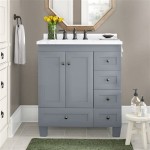What Kind of Paint Do You Use On A Bathroom Vanity Top?
Selecting the appropriate paint for a bathroom vanity top is a critical decision that significantly impacts its longevity, aesthetics, and resistance to moisture. Unlike surfaces in other areas of the home, bathroom vanity tops are consistently exposed to humidity, splashes, and potential contact with various cleaning agents. Therefore, the choice of paint must prioritize durability, water resistance, and the ability to withstand daily wear and tear. Several types of paint possess the necessary qualities for this application, but a thorough understanding of their characteristics is paramount to achieving a lasting and visually appealing finish.
The ideal paint for a bathroom vanity top should form a robust barrier against moisture penetration, preventing warping, blistering, and eventual decay of the underlying material. Furthermore, it should be able to endure frequent cleaning without fading, chipping, or losing its sheen. The selection process should also consider the existing material of the vanity top. Laminate, wood, and solid surface materials each present unique challenges and require specific preparation techniques and paint formulations for optimal adhesion and performance.
Understanding the Key Requirements for Bathroom Vanity Top Paint
Several key factors must be considered when deciding on the type of paint for a bathroom vanity top. Water resistance is paramount, as prolonged exposure to moisture can lead to significant damage. Durability is also essential, as the vanity top is a high-traffic area prone to scratches, stains, and general wear. Ease of cleaning is another important consideration, as the surface will require regular maintenance to keep it looking its best. Finally, the aesthetic appeal of the paint is crucial, as it should complement the overall design of the bathroom.
The paint's resistance to mold and mildew is also a crucial aspect. Bathrooms provide an ideal environment for microbial growth, and a paint that inhibits this growth can significantly extend the lifespan of the vanity top. Furthermore, the paint should be low-VOC (Volatile Organic Compounds) to minimize any potential health risks and environmental impact. VOCs are organic chemicals that evaporate at room temperature and can contribute to indoor air pollution.
Exploring Popular Paint Options
Several types of paint are commonly used for bathroom vanity tops, each with its own set of advantages and disadvantages. These include oil-based paints, latex-based paints, epoxy paints, and specialized furniture paints. Understanding the properties of each type will facilitate an informed decision based on specific needs and preferences.
Oil-Based Paints: While they were a traditional choice for their durability and hard finish, oil-based paints have largely fallen out of favor due to their high VOC content, extended drying times, and the need for mineral spirits for clean-up. They offer excellent water resistance but are less flexible than latex paints, making them more prone to cracking over time. Furthermore, oil-based paints tend to yellow with age, which can detract from the aesthetic appeal of the vanity top.
Latex-Based Paints: Latex paints are a more popular choice for bathroom vanity tops due to their lower VOC content, faster drying times, and ease of cleaning with soap and water. They are also more flexible than oil-based paints, making them less prone to cracking. However, latex paints may not be as durable or water-resistant as oil-based paints, so it is crucial to select a high-quality, 100% acrylic latex paint specifically formulated for use in bathrooms. Look for options with added mildew resistance for optimal performance.
Epoxy Paints: Epoxy paints offer exceptional durability and water resistance, making them a suitable option for bathroom vanity tops that are subjected to heavy use. They form a hard, protective coating that is resistant to scratches, stains, and chemicals. However, epoxy paints can be more difficult to apply than other types of paint, requiring careful surface preparation and specialized application techniques. They also tend to have a strong odor and may require the use of respirators during application.
Specialized Furniture Paints: Several specialized furniture paints are specifically designed for use on cabinets and vanities. These paints often contain additives that enhance their adhesion, durability, and water resistance. They are typically available in a wide range of colors and finishes, allowing for greater customization. Chalk paints and mineral paints fall into this category and are often used for creating distressed or vintage looks. While they offer unique aesthetic possibilities, they typically require a sealant or topcoat to provide adequate water resistance for bathroom environments.
Detailed Examination of Recommended Paint Types for Bathroom Vanity Tops
A more in-depth look at latex-based acrylic paints and specialized furniture paints will provide better information for selecting the appropriate paint for a bathroom vanity top. Both offer advantages that make them suitable choices when applied with the proper preparation and topcoat.
Latex-Based Acrylic Paints: Focusing on 100% acrylic latex paints is crucial. Acrylic resins provide superior adhesion, durability, and water resistance compared to other types of latex paints. When selecting a latex paint for a bathroom vanity top, look for a product specifically formulated for use in kitchens and bathrooms. These paints typically contain added mildewcides to inhibit mold and mildew growth. A semi-gloss or gloss finish is recommended as these finishes are more water-resistant and easier to clean than matte or eggshell finishes. Proper surface preparation is essential for achieving optimal adhesion. This includes cleaning the surface thoroughly with a degreaser, sanding to create a slightly rough surface, and priming with a high-quality primer. Multiple thin coats of paint are preferable to one thick coat, as this will result in a smoother, more durable finish. Allow each coat to dry completely before applying the next.
Specialized Furniture Paints (Chalk Paint and Mineral Paint): These paints are popular for their ease of application and ability to create a vintage or distressed look. Chalk paint has a matte finish and adheres well to most surfaces, often requiring minimal sanding or priming. Mineral paint is similar to chalk paint but contains added minerals for enhanced durability and adhesion. While these paints offer excellent aesthetic possibilities, they are not inherently water-resistant and require a topcoat to protect them from moisture. A high-quality water-based polyurethane or varnish is recommended as a topcoat. Apply several thin coats of the topcoat, allowing each coat to dry completely before applying the next. Ensure that the topcoat is specifically formulated for use on painted surfaces to avoid yellowing or other undesirable effects. When using chalk paint or mineral paint, consider the overall design of the bathroom and whether a distressed or vintage look is appropriate. These paints may not be suitable for modern or contemporary bathrooms.
Regardless of which paint type is chosen, preparation is key. This includes cleaning, sanding, and priming.
The Importance of Proper Preparation
Regardless of the selected paint type, thorough surface preparation is paramount to achieving a professional and long-lasting finish. Inadequate preparation can lead to poor adhesion, premature peeling, and ultimately, the failure of the paint job. The preparation process typically involves cleaning, sanding, and priming the surface.
Cleaning: Begin by thoroughly cleaning the vanity top with a degreasing cleaner to remove any dirt, grime, or grease. Rinse the surface with clean water and allow it to dry completely. For stubborn stains or grease, consider using a stronger cleaner, such as TSP (trisodium phosphate), but be sure to follow the manufacturer's instructions carefully and wear appropriate protective gear.
Sanding: Sanding the surface creates a slightly rough texture that allows the paint to adhere properly. Use a medium-grit sandpaper (around 120-180 grit) to sand the entire surface, paying particular attention to any areas that are glossy or have existing paint. After sanding, remove all dust with a tack cloth or a damp cloth. For laminate surfaces, use a finer-grit sandpaper (around 220 grit) to avoid damaging the underlying material.
Priming: Priming is an essential step in the painting process, as it provides a uniform surface for the paint to adhere to and helps to seal the surface. Use a high-quality primer specifically designed for the type of material the vanity top is made of. For example, use a bonding primer for laminate surfaces and a stain-blocking primer for wood surfaces. Apply the primer in thin, even coats, following the manufacturer's instructions. Allow the primer to dry completely before applying the paint. Tinting the primer to match the color of the paint can improve coverage and reduce the number of coats of paint required.
The combination of proper paint selection and surface preparation will significantly enhance the likelihood of a durable and aesthetically pleasing bathroom vanity top.

Paint Bathroom Vanity Countertop Sink So Easy A Piece Of Rainbow

Paint Bathroom Vanity Countertop Sink So Easy A Piece Of Rainbow
:strip_icc()/101922779-2cbc45e123c34827afb4f601723b03ca.jpg?strip=all)
How To Paint Bathroom Countertops

Paint Bathroom Vanity Countertop Sink So Easy A Piece Of Rainbow

How To Easily Spray Paint Bathroom Countertops My Homier Home

Should You Be Painting Your Bathroom Countertops Caesarstone

Can You Paint A Countertop Re Sick Of Absolutely Recreated Designs

How To Paint Tile Countertops And Our Modern Bathroom Reveal Bright Green Door

I Have Always Wanted To Paint My Bathroom Countertop Hometalk

How To Paint Laminate Cabinets Love Renovations
Related Posts







